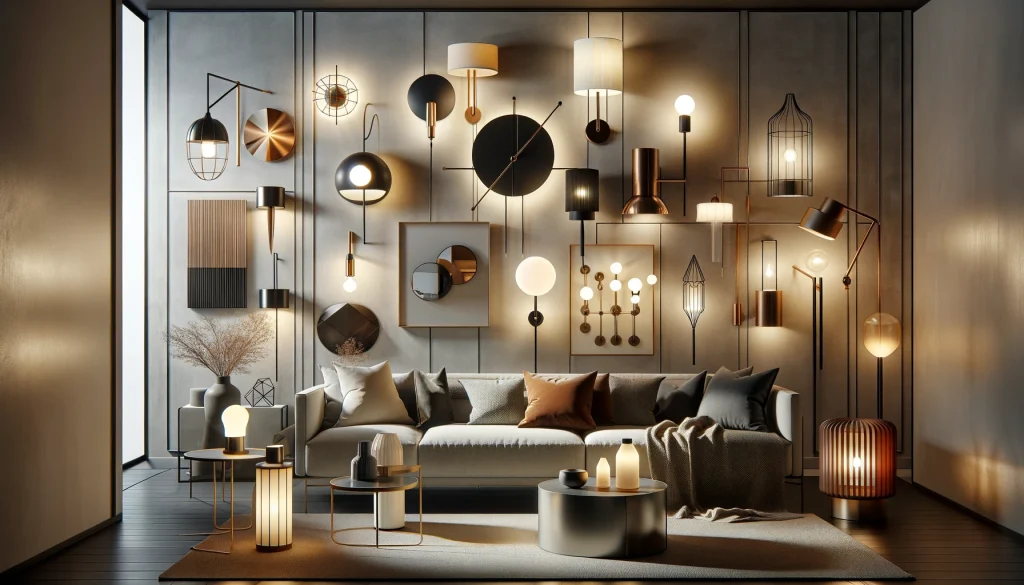Wall lamps are not just functional items but also play a significant role in the interior design of a home. They can add a touch of elegance, create a cozy ambiance, and highlight architectural features. Whether you’re in the market for modern LED designs or classic sconces, understanding the various types and benefits of indoor wall lamps is key to choosing the perfect lighting for your space.
Types of Wall Lamps
Wall lamps come in various styles to cater to different tastes and purposes. Indoor wall sconces are popular for their decorative flair and ambient lighting, often used in hallways and bedrooms. For those seeking a contemporary look, modern wall lamps offer sleek design and innovative lighting technology. Spotlight-style fixtures like the RANARP provide directional lighting, ideal for reading nooks or highlighting artwork.
Designer wall lamps are another category that can transform the aesthetic of a room. Brands like Flos and Foscarini are known for their artistic and sophisticated designs, blending functionality with high-end style. LED wall lamps have become increasingly popular due to their energy efficiency and long lifespan, making them a sustainable choice for homeowners.
Wall lamp varieties also include adjustable arm lamps, picture lights, and swing lamps, allowing for customization of lighting in any space. The selection of materials, from sleek metals to natural bamboo as seen in the SINNERLIG collection, provides additional options for personalizing your home’s look.
How to Choose the Perfect Wall Lamp
Selecting the ideal wall lamp involves considering both aesthetic and functional factors. Firstly, identify the purpose of the lighting: is it for general ambiance, task lighting, or accenting features in a room? Then, consider the style of your interior decor and choose a design that complements it.
Wall lamp installation tips suggest assessing the available space and the type of wall material, which could influence the fixture’s weight and installation method. The light’s color temperature and bulb type also play a role in creating the desired mood. For bedrooms, softer and warmer tones are recommended, whereas cooler tones may be better suited for workspaces.
The lamp’s size and scale should be proportional to the room and furniture it accompanies. A designer wall lamp might serve as a focal point, while subtler models should blend seamlessly with the surroundings. Always check the product specifications and consult with a professional if unsure about the electrical requirements and installation process.
Here are some ideas:







Benefits of LED Wall Lamps
LED technology has revolutionized home lighting, offering a multitude of benefits. Energy-efficient wall lamps with LED bulbs consume less electricity, leading to lower utility bills and a reduced carbon footprint. They also have a longer lifespan, meaning fewer replacements and less waste.
LED wall lamps provide consistent light quality without emitting heat, making them safe to use for extended periods. They are also available in various color temperatures, from warm to cool, allowing for customization according to the room’s function and ambiance. Additionally, LED lamps are often dimmable, giving you control over the brightness and mood in your space.
Their versatility is unmatched, with designs that can be sleek and minimalist or bold and sculptural. Whether it’s for task lighting in the kitchen or accent lighting in the living room, LED wall lamps fit the bill for both functionality and style.
Wall Lamp Placement Tips
Proper placement of wall lamps is crucial for achieving the desired effect. For long rooms with low ceilings, wall-mounted fixtures can help draw the eye upward, creating the illusion of height. In bedrooms, the placement of bedside lamps should be at eye level when sitting up, to provide optimal lighting for reading without glare.
In living spaces, consider the natural flow of the room and place lamps in areas that require additional light or where you want to create a focal point. Hallways and entryways benefit from evenly spaced scones, offering a welcoming glow and safe navigation through the space.
For art enthusiasts, picture lights or adjustable wall spotlights can highlight paintings or sculptures, enhancing the visual impact of your collection. Remember to factor in the direction and angle of the light to avoid unwanted shadows and glare.
Designer Wall Lamps From Top Brands
Investing in designer wall lamps can elevate the sophistication of any room. Brands like Flos, Foscarini, and Kartell are renowned for their visionary designs and high-quality craftsmanship. These lamps often serve as conversation pieces, blending art with functionality.
The SINNERLIG collection is noted for its hand-braided bamboo fixtures, offering a natural and warm aesthetic. The versatility of designer lamps is evident in the range available, catering to minimalist tastes with clean lines as well as more extravagant styles with bold shapes and colors.
When choosing a designer lamp, consider the brand’s reputation for durability and customer service. It’s also worth noting that some designer lamps are part of limited editions, making them not just a source of light but also a potential investment piece.
Frequently Asked Questions About Wall Lamps
Many homeowners have questions regarding the selection, placement, and maintenance of wall lamps. Here, we address some of the most commonly asked questions to help you make an informed decision.
What Is a Lamp on the Wall Called?
A lamp mounted on the wall is commonly referred to as a wall lamp or wall sconce. They come in various designs and are used for different purposes, from providing ambient lighting to serving as decorative elements in a space.
What Are the Disadvantages of Wall Lamps?
While wall lamps offer many benefits, they can have disadvantages, such as potential installation challenges, especially in homes without existing wall wiring. They may also be less flexible compared to freestanding lamps, as they are fixed in one place.
How Do I Choose a Wall Lamp?
To choose a wall lamp, consider the room’s lighting needs, the style of decor, the size of the space, and the type of activities that will take place there. It’s also important to think about the installation process and whether the lamp’s design will complement other fixtures in the room.
How High Should a Wall Lamp Be in a Bedroom?
In a bedroom, a wall lamp should typically be mounted with the bottom of the shade at eye level when seated in bed, which is usually around 48 to 60 inches from the floor. This placement ensures optimal lighting for reading and a comfortable glow.
With the right selection and placement, wall lamps can significantly enhance the ambiance and functionality of your home. From energy-efficient LED options to exquisite designer pieces, there’s a wall lamp to suit every style and need.



